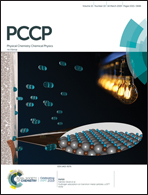Temperature and isomeric effects in nanoclusters
Abstract
The canonical thermodynamics of clusters is determined quantum mechanically in the general case of multiple minima of the potential energy surface (PES) using the superposition approximation. As an illustration of the consequences of our approach, we study in detail the thermodynamic properties of CuN clusters with N from 2 to 150 as a function of cluster size, temperature, and number of isomers. Thereby, for instance, solid–solid transition temperatures for several cluster sizes are determined. We show that the cluster vibrations have a strong impact on the stability of the clusters and that this can be observed not only at medium and high temperatures but also at low temperatures and even at T = 0 K. Thus, including zero-point corrections can change the relative energetic ordering of different isomers. This isomeric effect results in an oscillatory dependence of the heat capacity on cluster size at moderate and high temperatures. Moreover, for the identification of magic clusters at non-vanishing temperature, the Helmholtz free energy is analyzed as a function of cluster size and temperature within a one-, two-, and three-minima model of the PES. Thereby, we demonstrate that the concept of magic clusters is strongly temperature dependent so that in several cases clusters change from being magic or non-magic at T = 0 K to be the opposite at non-vanishing temperature. We emphasize that all these effects are not specific for copper clusters alone but can also be observed in other metal or semiconductor nanoclusters.



 Please wait while we load your content...
Please wait while we load your content...